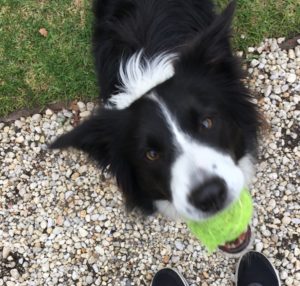Having your pet go missing is a very traumatic experience, and it can be hard to know what to do if you have a lost dog or cat.
The importance of microchipping your dog and cat
Even though the microchipping of dogs and cats is compulsory across most of Australia, far too many of them end up lost and in shelters due to contact details not being up to date.
With cats in particular, the large majority not microchipped at all, which is why so many end up in pounds and shelters and facing euthanasia.
The sad thing about this is that there is really no reason to not have your dog or cat microchipped. It costs anywhere between just $10 and $80 and is a once off fee, so if your dog or cat is not microchipped talk to your local PETstock Vet before they become a lost dog or cat.
Microchips are safe, around the size of a grain of rice and won’t cause any discomfort once inserted. Each chip has a unique number that is detected using a microchip scanner.
The microchip number is recorded on a database registry with details about the animal and owner. Should your pet stray or become lost, vets, animal shelters and local councils can scan your pet for a microchip and contact you via the database.
It is vital though that if you change phone numbers or move house that you update your contact details, so do ask your vet to regularly scan the chip to ensure it’s readable and hasn’t moved around so you know your pet will be safe if you have a lost dog or cat.
Ensure your pet is wearing an ID Tag
The fastest way to have a lost dog or cat returned to you is to ensure they are wearing a collar and an ID tag , and that it is clear readable.
If your dog is frightened or in an accident their collar may be removed though, so that is why microchipping along with an ID tag is required.
Check out the cool range of ID tags at your local PETstock store or their website, including some breed specific designs, as they offer free engraving too.
What to do if you have a lost dog or cat
- Firstly search your home and yard, closed bedroom doors (I’ve found a dog I thought had gone missing sleeping under the bed in a spare room once!), under the house, the car, anywhere they could have accidentally gotten stuck or are hiding in.
- Let your neighbours know that your pet is missing. Make sure you take a recent photo to show them.
- Walk or drive around the neighbourhood calling your pet’s name. If your dog is lost, concentrate on the areas where you usually take it on walks and any other places you have recently visited.
- Create a ‘Lost Dog’ or cat flyer and distribute it to houses and shops in your neighbourhood. The flyer should include a photo, your pet’s name, a detailed description and where they were last seen, as well as your name and contact number. Try offering a reward too.
- If your pet is microchipped and the details are not current, contact the microchip agency and update your details immediately.
- If you don’t know which agency your pet is registered with you can check with Pet Address or one of the leading databases listed in the article HERE.
Who to contact if you have lost a dog or cat
- Call around all of the local vets in your area and emergency clinics and provide them with all of the details of your lost dog or cat.
- There are many local and state and national lost pet groups on social media, so get straight on those and let people know. Members of these local community groups are wonderful at offering to go out and look in the local area, whilst others who find a pet often post on these pages. Notify the administrators as well.
- If it is daytime also call the council pound, as a member of the community may have seen it and notified the council.
- Try any local animal shelters in your area and surrounds.
- Some local radio stations will also make announcements about lost pets.
- Let your local pet stores know as well.
If your dog is scared of fireworks or thunderstorms which is a very common phobia, this is a time many dogs escape their homes trying to flee the noise. Here are some tips to help keep your dog safe during fireworks and thunderstorms.
What to do if you find a lost dog or cat
- Calmly approach the lost dog or cat, pat your leg and call them over to you. Take off hats and sunglasses so you don’t look intimidating and even get down to their level. Don’t chase them or run towards them, as they are likely already frightened and nervous in unfamiliar surroundings.
- Once you have safe hold of the animal, make sure to keep them in a safe place away from dangerous roads and busy crowds. Try to get some help from others to stop traffic if they are running back and forth in between a busy road and keep everyone calm so the dog can calm down or try to move them in a direction away from the road.
- If they are running along a road in fears, often a good tip is to pull over and open your car door and call them in. A scared dog will often go for that safe place to hide option.
- Check if the animal has a collar or any form of visible identification and call the owner if they do.
- Take the animal to a vet to scan for a microchip and the contact details of the owner. This is the easiest and quickest way for pets to be reunited once lost. Unfortunately, pets that aren’t microchipped have a much smaller chance of finding their owners. Note: microchips can move from their original spot, so if a microchip is not found immediately, encourage the vet or shelter to scan the pet’s entire body.
- File a found report – if you haven’t been able to find and contact the owner, call your local animal shelter and council to file a found report, as these are likely the first places the owner will call when they discover their pet is missing. Leave your name and number, so the shelter or council can call you back if they hear from the owner and the pet can be returned as quickly as possible.
- Utilise social media – Social media is a great way to spread a message quickly in the local community. Post a photo and description of the pet to your local lost pet page or community group. However, don’t rely on it wholly, as some people may not be active on social media.
- Let local pet stores know or take them in in case they can recognise the dog, likewise with local groomers.
- Take the lost dog or cat o the local shelter – If you can’t contact the owner, the best thing to do is to take the pet to the animal shelter so the owner can go to collect them as this is the most obvious place for them to look. Give full details on where you found the lost dog or cat, and at what time, so they can file an accurate report and identify the owner.
Remember if you do lose a dog or cat, don’t give up. Keep going back to the shelter and calling the vets. Don’t wait a few days for them to return either, get onto it immediately so you don’t risk your pet being re-homed, or worse, euthanised. Sadly, this does happen as our shelters and pounds are at capacity all over Australia.
About the Author: Lara Shannon is a certified dog behaviourist and trainer, pet food nutrition specialist, Executive Producer and Host of Pooches at Play on Channel 10 and editor of Poochesatplay.com. Lara also runs her own dog training business in Melbourne’s Bayside area and is the Author of World of Dogs and Eat, Play, Love Your Dog







